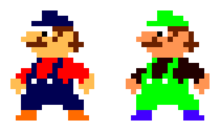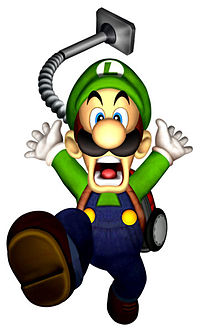- Luigi
-
This article is about the Nintendo character. For other uses of the name Luigi, see Luigi (disambiguation).
Luigi 
Luigi as seen on New Super Mario Bros. Wii. (2009)Series Mario First game Mario Bros. (1983) Created by Shigeru Miyamoto Voiced by (English) Video games:
Television:
Mark Graue (Hotel Mario)
Charles Martinet (1996-present)
Danny Wells (The Super Mario Bros. Super Show)
Tony Rosato (Super Mario Bros. 3 and Super Mario World)Voiced by (Japanese) Ichirōta Miyagawa (BS Super Mario USA Power Challenge, Excitebike: Bun Bun Mario Battle Stadium)
Yū Mizushima (Super Mario Bros.: Peach-Hime Kyushutsu Dai Sakusen!)
Naoki Tatsuta (OVA trilogy)Portrayed by Danny Wells (The Super Mario Bros. Super Show)
John Leguizamo (film)
Hiroyuki Yabe (Hot Mario Bros.)Luigi (ルイージ Ruīji) is a fictional character, featured in video games and related media released by Nintendo. Created by prominent game designer Shigeru Miyamoto, Luigi is portrayed as the slightly younger fraternal twin brother of Nintendo's mascot Mario, and appears in many games throughout the Mario series, frequently as a sidekick or deuteragonist to his brother.
Luigi first appeared in the 1983 arcade game Mario Bros. as the character controlled by the second player, and retained this role in Super Mario Bros., Super Mario Bros. 3, Super Mario World, and other titles. The first game where he was available as a primary character was Super Mario Bros. 2. In more recent appearances, Luigi's role became increasingly restricted to spinoffs such as the Mario Party and Mario Kart series, though he has been featured in a starring role on two occasions: first in the 1991 educational game Mario is Missing, later in Luigi's Mansion for the Nintendo GameCube in 2001 and in Luigi's Mansion 2 for the 3DS. In both of these games, he is called upon to act as the hero because Mario, the usual hero within the franchise, is in need of rescue. Luigi has also appeared in every episode of the three DiC TV series based on the Nintendo Entertainment System and Super Nintendo Entertainment System games.
Originally developed as a palette swap of Mario with a green color scheme instead of red, Luigi has since developed a personality and style of his own. As his role in the Mario series progressed, Luigi evolved into a physically distinct character, taller and thinner than his brother. Although as kindhearted as Mario, Luigi is portrayed as timid and sometimes cowardly, especially in the presence of ghosts or when faced with seemingly impossible tasks to accomplish.
Contents
Concept and creation
The events leading to Luigi's creation began in 1982, during the development of Donkey Kong, where the Nintendo designer Shigeru Miyamoto had created Mario (then known as "Jumpman") hoping that he would be able to recast the character in a variety of different roles in future games.[1] Miyamoto had been inspired by the game Joust to create a game with a simultaneous two-player mode, which led to his development of the game Mario Bros. in 1983, with Luigi filling the role of Mario's brother as the second playable character.[2] Luigi's name is said to have been inspired by a pizza parlor near Nintendo of America's headquarters in Redmond, Washington, called "Mario & Luigi's".[2] Miyamoto observed that the word ruiji means "similar" in the Japanese language, and that Luigi was designed to have the same size, shape and gameplay of Mario.[3]
While Mario was originally portrayed as a carpenter in Donkey Kong, the duo of Mario and Luigi in Mario Bros. were styled as Italian plumbers by Miyamoto, on the suggestion of a colleague.[4] Software constraints of the time—similar to those that gave Mario his distinctive look in Donkey Kong—meant Luigi's first appearance was restricted to a simple palette swap of Mario designed to represent the second player. Graphically and in terms of gameplay, the characters were completely identical, except for their color schemes;[5] the green color scheme adopted for Luigi would remain one of his defining physical characteristics in subsequent releases.
After the success of Mario Bros., Luigi was introduced to a wider audience in 1985 with the release of the console game Super Mario Bros. Once again his role was restricted to a palette swap of Mario, functioning as the second-player in a similar fashion to Mario Bros.. The subsequent release of Super Mario Bros.: The Lost Levels in 1986, however, marked the beginning of Luigi's development toward becoming a more distinguished character. As with his previous appearances, Luigi remained a palette swap of Mario. While this version of Super Mario Bros. 2 was released in Japan, it was deemed to be too difficult for American audiences at the time,[4] leading to the development of an alternative release for the latter; this version would play a key role in shaping Luigi's current appearance.[4]
In 1988, consequently, a version of Yume Kōjō: Doki Doki Panic with the graphics altered to represent characters and scenes from the Mario franchise was released in the United States as Super Mario Bros. 2. In this release, the character of "Mama" served as the template for Luigi, resulting in his gaining a taller, thinner look, complete with his ubiquitous green color scheme. Official artwork for Super Mario Bros. 3 and Super Mario World depict Luigi with this new look, however Nintendo of Japan would not adapt his artwork differences to his look in-game until the 1992 game Super Mario Kart. Luigi's distinguished appearance from the Yume Kōjō: Doki Doki Panic-inspired version of Super Mario Bros. 2 has been used ever since, even in remakes of games where he was originally a palette swap.
Actor portrayal
Upon debuting on the Nintendo 64, Luigi received a voice, provided by Charles Martinet, who also voices Mario, Wario, Waluigi, and Toadsworth. Much like his appearance, Luigi's vocal portrayal has fluctuated over the years. When first introduced in Mario Kart 64, Luigi's voice was considerably lower in pitch than Mario's (although it was high pitched in the Japanese version[citation needed]); however, in Mario Party, his voice has a much higher pitch, similar to Mario's voice (the same voice from the Japanese Mario Kart 64). He retained this higher voice in Mario Party 2. In Mario Golf, Mario Tennis, and Mario Party 3, his voice returned to a lower state. Since then, with the exceptions of Mario Kart Super Circuit and Super Smash Bros. Melee, Luigi has consistently had a medium-pitched voice. In Mario Kart Super Circuit, Luigi's voice was the same high voice from the Japanese Mario Kart 64. In Super Smash Bros. and Super Smash Bros. Melee, Luigi's voice is made up of clips from Mario's voice taken from Super Mario 64, with raised pitches. In Super Smash Bros. Brawl, he has his own voice instead of a pitched-up version of Mario's.
Characteristics
 The arcade version of Mario Bros., released in 1983, featured Luigi (right) in his debut appearance as a palette swap of Mario.
The arcade version of Mario Bros., released in 1983, featured Luigi (right) in his debut appearance as a palette swap of Mario.
Luigi is portrayed as the taller, younger brother of Mario, and he is usually seen dressed in green with overalls.[6] Although Luigi is a plumber,[6] like his brother, other facets of his personality vary from game to game. Luigi always seems nervous and timid but is good-natured and not as quick to anger as his more famous brother.
While it has not been made official, Daisy may be Luigi's romantic interest. They were a romantic couple in the Super Mario Bros. film[citation needed] and in Mario Kart Wii they are seen in statue dancing together.[citation needed] She was his caddy in NES Open Tournament Golf[7] as Peach was to Mario. Also on Daisy's trophy in Super Smash Bros. Melee, it says that she is possibly Luigi's answer to Mario's Peach.[citation needed]
Appearances
Mario series
 Luigi as seen in Luigi's Mansion. The vacuum was listed as one of the best Nintendo gimmicks by GameDaily.
Luigi as seen in Luigi's Mansion. The vacuum was listed as one of the best Nintendo gimmicks by GameDaily.
Luigi's first appearance was in the 1983 arcade game Mario Bros.[6] as the character controlled by the second player. He retained this role in Wrecking Crew. He later appeared in Super Mario Bros.[6] for the NES, and again in Super Mario Bros.: The Lost Levels, Super Mario Bros. 2, Super Mario Bros. 3, and Super Mario World. Super Mario Bros. 2 introduced Luigi as the taller of the two brothers, as well as the better jumper. Super Mario Bros. 3, and Super Mario World returned to featuring Luigi as a reskinned Mario. He made a minor appearance in his baby form in Super Mario World 2: Yoshi's Island. Beginning with Super Mario 64, Luigi made no appearances in main Mario titles, including the sequel Super Mario Sunshine. However, the Nintendo DS remake of Super Mario 64 features him as a playable character alongside Mario, Yoshi, and Wario. He received his own starring role in the Nintendo GameCube video game Luigi's Mansion, where he wins a mansion from a contest he never entered, and saves Mario from King Boo. Luigi became playable in the Nintendo DS game New Super Mario Bros. as a hidden character, and as a hidden character in the Wii game Super Mario Galaxy. In its sequel, Super Mario Galaxy 2, the player can switch out for Luigi throughout the game.[8] He also appears as a playable character in New Super Mario Bros. Wii, where four players can play at once cooperatively as Mario, Luigi, and two Toads. He will star in the upcoming Luigi's Mansion 2.[9] He will appear in Super Mario 3D Land as a playable character
Appearance in other games
Luigi appears in all of the Mario spin-offs, including Mario Kart, Mario Party, and Mario sports titles. He also appears in all installments of the Super Smash Bros. series as an unlockable character in each.
Luigi has appeared in every Mario role-playing game. While he originally made a cameo appearance in the end credits of Super Mario RPG: Legend of the Seven Stars, he appears more prominently in the Paper Mario series. He is a non-playable character in the original Paper Mario. In the sequel Paper Mario: The Thousand-Year Door, he appears yet again as a non-playable character, going on a separate adventure from Mario's. Super Paper Mario features him as a playable character after he is initially brainwashed into working for the antagonist under the name "Mr. L". The Mario & Luigi series features Luigi as a main protagonist; the events of the game focus on him and his brother Mario. He has appeared in all three Mario & Luigi games, Mario & Luigi: Superstar Saga, Mario & Luigi: Partners in Time, and Mario & Luigi: Bowser's Inside Story.
Other media
See also: Super Mario Bros.: Peach-Hime Kyushutsu Dai Sakusen!, Super Mario Bros. (film), and Super Mario Bros. (TV series)Luigi made his animated debut in the 1986 Original video animation Super Mario Bros.: The Great Mission to Save Princess Peach. In the film, he was voiced by Yū Mizushima and had a different color sceme than he has today, sporting a blue cap, blue overalls, and a yellow shirt. This was because he was not yet given a consistent color scheme. In the OVA, Luigi was very greedy and even left Mario at one point to look for coins. He was also a little more serious than his brother Mario, who constantly would daydream about Princess Peach, although he is not as brave as Mario.[citation needed]
Luigi later made an appearance in the third of a trilogy of OVAs released in 1989, in which the Mario characters acted out the story of Snow White. He appears at the end of the video to save Mario and Peach from the Wicked Queen, portrayed by Bowser (called "Koopa" in Japan).[citation needed]
Luigi regularly appeared in The Super Mario Bros. Super Show!, airing from 1989 to 1990, which cast Danny Wells as both his live-action portrayal and voice. Like his brother, Luigi's voice actor changed in later cartoons, in his case to Tony Rosato. Even though he was not the starring character in the show, Luigi appeared in every episode of the three DiC Mario cartoons (91 episodes in total), in one of which Mario himself did not appear.[citation needed]
Luigi played a different role in the Super Mario Bros. film, where he was portrayed by John Leguizamo.[10] He was a more easy-going character in contrast to the cynical Mario (played by Bob Hoskins[10]) in the film.
Luigi has also appeared in several Robot Chicken sketches, always alongside Mario.[citation needed] In one sketch, he and Mario accidentally appear in Vice City, from the Grand Theft Auto series, while another features them competing in a Cannonball Run-styled car race.[citation needed]
Reception
Since his appearance in Super Mario Bros., Luigi has received generally positive reception. Nintendo Power listed Luigi as their fifth favourite hero, citing his dependability while describing him as being an underdog. They also listed him as having one of the best mustaches.[11] GameDaily listed the "neglected guy" as one of their top 25 video game archetypes, citing Luigi as an example and stating that he lacks the charisma of his brother Mario and that he should get another starring role.[12] They also listed Luigi's Poltergust 3000 from Luigi's Mansion as one of the top 25 Nintendo gimmicks.[13]
References
- ^ Demaria, R: "High Score! The Illustrated History of Electronic Games", page 238. McGraw Hill-Osbourne, 2002
- ^ a b "Mario Bros. Arcade". International Arcade Museum. http://www.arcade-museum.com/game_detail.php?letter=&game_id=8624. Retrieved 2006-08-14.
- ^ New Straits Times, 10 August 1986. [1]
- ^ a b c McLaughlin, Rus (8 November 2007). "The History of Super Mario Bros.". IGN. http://au.games.ign.com/articles/833/833615p1.html. Retrieved 7 January 2010.
- ^ "Nintendo's Shining Star: The History of Mario". Gamecubicle. http://www.gamecubicle.com/features-mario-nintendo_shining_star.htm. Retrieved 2006-12-16.
- ^ a b c d "Luigi Biography". IGN. http://stars.ign.com/objects/924/924288_biography.html. Retrieved 2010-05-09.
- ^ "IGN: Princess Daisy Biography". Stars.ign.com. 2010-07-07. http://stars.ign.com/objects/963/963167_biography.html. Retrieved 2010-08-10.
- ^ Words: Henry Gilbert, GamesRadar US. "Luigi in Mario Galaxy 2? Official Japanese site says yes, Super Mario Galaxy 2 Wii News". GamesRadar. http://www.gamesradar.com/wii/super-mario-galaxy-2/news/luigi-in-mario-galaxy-2-official-japanese-site-says-yes/a-20100422145740537034/g-2009060210524839056. Retrieved 2010-08-10.
- ^ Brown, Andrew (June 7, 2011). "Luigi's Mansion 2 to Haunt Nintendo 3DS". Nintendo World Report. http://www.nintendoworldreport.com/news/26596.
- ^ a b "At the Movies:Super Mario Bros.". http://classic-web.archive.org/web/20080317071330/http://bventertainment.go.com/tv/buenavista/ebertandroeper/index2.html?sec=6&subsec=Super+Mario+Bros.. Retrieved January 25, 2010.
- ^ Nintendo Power 250th issue!. South San Francisco, California: Future US. 2010. pp. 40, 47.
- ^ January 23, 2009 (2009-01-23). "Gallery and Images". GameDaily. http://www.gamedaily.com/articles/galleries/top-25-video-game-characters-archetypes/?page=9. Retrieved 2010-08-10.[dead link]
- ^ Chris Buffa (2009-06-19). "Gallery and Images". GameDaily. http://replay.web.archive.org/20090626060346/http://www.gamedaily.com/articles/galleries/top-25-nintendo-gimmicks/?page=4. Retrieved 2010-08-10.
External links
- Luigi at the Internet Movie Database
- Nintendo's official website
- Mario Bros. at the Killer List of Videogames
Characters in the Mario series and spin-offs Protagonists Antagonists Supporting Birdo • Diddy KongEnemies Goomba • LakituCategories:- Fictional American people of Italian descent
- Fictional plumbers
- Fictional sportspeople
- Fictional twins
- Film characters
- Male video game characters
- Mario characters
- Nintendo protagonists
- Super Smash Bros. fighters
- Video game sidekicks
- Fictional characters introduced in 1983
Wikimedia Foundation. 2010.

